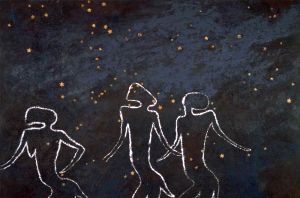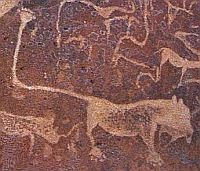
|
|
AfricaStar Lore
|
|


|
|
Boötes
Khoe-Sān is a generic term for all of the "non-Bantu" indigenous peoples of Southern Africa.
Various groups call
Arcturus (α Boo) the Fire-Finishing Child,
as it sets around the morning when when the firewood has been exhausted.
|

|



|
|
Canis Major / Sirius
|
|
|
Serer
In the creation myth of the
Serer people in what is now Senegal,
and in their cosmology, Sirius is called the Star of Yoonir.
|
 Yoonir, Symbol of the Universe
Yoonir, Symbol of the UniverseSource: Wikipedia |



|
|
|
Canis Major and
Carina
|
|
|
Khoe-Sān
Sirius (α CMa) and Canopus (α Car)
are the two brightest stars in the night sky.
|

|



|
|
|
Canis Minor and
Gemini
|
|
|
/Xam
To the /Xam in southern Africa, the bright stars Castor (α Gem) and
Pollux (β Gem) were two female
eland antelopes with Procyon (α CMi), the
bright star in Canis Minor being their male companion.
|

|



|
|
|
Carina and
Eridanus
|
Canopus (α Car), the second brightest star in the night sky is known as as Naka (Sotho, Tswana) or
Nanga (Venda), the Horn Star
throughout southern Africa.
 Similarely, Achernar (α Eri), the brightest star in the constellation Eridanus is called Senakane (Sotho, Tswana) and Tshinanga (Venda), meaning the Little Horn.  The "Horn" most likely refers to a horned animal, like an antelope, as the Magellanic Clouds are considered the tracks of the "Horn Star" and the "Little Horn" by the Sotho people.  Source: ASSA - African Ethnoastronomy |
 Antelopes in a rock painting
Antelopes in a rock paintingSource: Don Hitchcock |

|
|
/Xam
The /Xam called Canopus (α Car) the Ant Egg Star as they believed it could
influence the the availability of one of their main protein source: ants’ eggs.
|

|
|
Sotho
The appearance of Naka (Canopus) heralds coming of winter and the browning of the fields. At the end of May, the Sotho people would hold a careful watch for Naka (Canopus) and the chiefs awarded a cow for its earliest sighting. At the day of
the sighting the medicine-men would perform a ceremony to judge whether the new season would be good or bad.
|

|
|
Tswana
To the Tswana, the appearance of Naka (Canopus) before sunrise signaled the beginning of the sheep-breeding season.
|

|
|
Venda
The Venda had a tradition similar to that of the Sotho: The first person to see Nanga in the morning sky would blow a black sable antelope horn called
phalaphala from a hilltop and would be rewarded with a cow.
|

|
|
Zulu
The Zulu had two names for Canopus (α Car), calling it inKhwenkwezi, the Brilliant Star and isAndulela, the messenger signaling the end
of Autumn, the harvest time.
|



|
|
Coalsack Nebula
The Coalsack Nebula is the most prominent dark nebula in the skies, visible to the naked
eye near the Southern Cross, as a dark patch obscuring a brief section of the Milky Way.
|
  Coalsack Nebula and Southern Cross
Coalsack Nebula and Southern CrossSource: Wikipedia |



|
|
|
Crux and Centaurus |

The further south one travels, the brighter the Southern Cross shines. Thus, not surprisingly, the constellation plays a prominent
role in star lore in southern Africa. Very often, the stars of the cross are combined with the two bright stars of Eridanus.
 Alpha Centauri, and Hadar (Beta Centauri) are among the brightest stars in the southern sky - Alpha Centauri is the third brightest star in the night sky. The two stars are called the Pointers, as a line connecting the two leads directly to the southern Cross.
|
|  Alpha and Beta Centauri pointing towards the Cross
Alpha and Beta Centauri pointing towards the CrossSource: earthsky.org |


|
|
Bedoin The Tuaregs call the four most visible stars of Crux iggaren - four Maerua crassifolia trees. |
 Maerua crassifolia
Maerua crassifoliaPlants of s. Morocco |


|
|
Mursi
The Mursi people of modern-day Ethiopia call the star Delta Crucis (also known as "Decrux")
Imai.
|
 Omo river;
Source: lifegate.com
Omo river;
Source: lifegate.com
|
The Mursi use a series of southern stars to mark their calendar to track seasonal flooding of the Omo river.
 In 2018, the Working Group on Star Names of the International Astronomical Union approved the name Imai for Delta Crucis.  Source: Wikipedia |

|
|
Sotho, Tswana,
Venda, /Xam,
Khoikhoi
The Sotho, Tswana and Venda call these stars Dithutlwa, the Giraffes. The bright stars of of the Cross are seen as male giraffes,
the two Pointers are female. The Venda called the fainter stars of the Southern Cross Thudana, The Little Giraffe.
|

|



|
|
Delphinus
In Setswana, the constellation Delphinus is called Gakgala, the Mopane Worm.
|

|



|
|
Eridanus
According to the Arab star name expert Paul Kunitzsch,
Bedouin Arabs visualized present-day
Achernar (α Eri) and
Fomalhaut (α PsA) as a pair of ostriches.
|

|

|
|
Sotho
To the Sotho in southern Africa the disappearance of the Pleiades and the
appearance of Achernar (α Eri) signals the beginning of the cold season.
|



|
|
Leo
|
|
|
/Gwi
Regulus (α Leo) is called /edzini, the Fire-Finisher by
the /Gwi of southern Afrika. Regulus only sets when the firewood has been exhausted.
|



|
|
Milky Way
|
|
|
Khoe-Sān
Khoe-Sān is a generic term for all of the "non-Bantu" indigenous peoples of Southern Africa. In a myth
told in the Kalahari Desert, long ago there were no stars and the night was pitch black until a
girl threw glowing embers into the night sky, where they remained as a wide, shimmering pathway illuminating the celestial firmament: the Milky Way.
|
 Dancing Girls © Gavin Jantjes
Dancing Girls © Gavin Jantjes
|
South African painter Gavin Jantjes captured a scene of dancing girls. To set the historic frame of deep time,
he rendered the dancing figures in a style reminiscent of southern Africa's ancient rock paintings.
 Sources: Smithsonian Institute, Wikipedia |



|
|
Orion
|
|
|
Khoe-Sān
Khoe-Sān is a generic term for all of the "non-Bantu" indigenous peoples of Southern Africa.
|

|

|
|
Maasai
In Masaai legend, there are three stars that follow one another like cattle, these are the stars of Orion's Sword and they are called The Old Men. Three other
stars - the stars of Orion's Belt - pursue them from the left. These are The Widows. The widows have lost their husbands and they are now waylaying the
old men.
|

|
|
Nama
For the Nama, Orion's Belt represented three Zebras. One day, the Khunuseti (the Pleiades) asked their husband Aob,
which is Aldebaran (α Tau) to shoot the Zebras.
Aob fired his arrow (Orion's Sword) but fell short of his target. He did not dare to retrieve his arrow because of the fierce lion (Betelgeuse) which sat watching
the zebras and he dared not return home because he had killed no game. Thus, there he sits forever, shivering in the cold night and suffering thirst and hunger.
|
 Rock art in Matobo Hills National Park, Zimbabwe
Rock art in Matobo Hills National Park, ZimbabweSource: africanrockart.org |

|
|
Songye
The Songye call the Belt Stars aspibwe na mbwa na nyama - a Hunter with a Dog and an Animal.
|

|
|
Tswana
The Tswana call Orion's Sword dintsa le Dikolobe - three dogs chasing three pigs. The three pigs, called Dikolobe are Orion's Belt.
|
 Warthog piglets
Warthog pigletsSource: San Diego Zoo |



|
|
Piscis Austrinus
|
|
|
Tswana
Fomalhaut (α PiA), is the brightest star of the constellation Piscis Austrinus and one of the brightest stars
in the southern hemisphere. The Tswana call it Ntshuna, the Kiss Me Star, as its rise indicates the time for lovers to part before
their parents discovered them.
|
|
|
Bedoin
According to the Arab star name expert Paul Kunitzsch,
Bedouin Arabs visualized present-day
Achernar (α Eri) and
Fomalhaut (α PiA) as a pair of ostriches.
|



|
|
Pleiades
|
|
|
Tuareg
The Tuareg Berbers of the northern Sahara call the Pleiades Cat iheḍ or ahăḍ, meaning "daughters of the night".
|
 Sahara Night; jaydearchives.com
Sahara Night; jaydearchives.com
|
This refers to the season during which the Pleiades rise and fall. When they "fall" with the sun on the west, it roughly means the hot, dry summer
is coming. When they rise from the east with the sun, the cold somewhat rainy season is coming. (Due to
Precession, these meanings may fade in the future.
 To many other Berber nations, the Pleiades are known as Tagemmunt. meaning "the group"  Source: Wikipedia |


|
|
Maasai
The Masaai call May the Month of the Pleiades. The disappearance of the Pleiades from the sky signals the end of the rain season.
|

|
|
Nama
For the Nama, the Pleiades are the Khunuseti, the daughters of the Sky God and the wifes of Aob, which is
Aldebaran (α Tau). For the full story, see Orion above.
|

|
|
Swahili
In Kiswahili, the Pleiades are called Kilimia, the Ploughing Stars or Digging Stars. The first appearance of the
Pleiades in June
is the beginning of the digging and growing season.
|

|
|
Xhosa
The Xhosa too call the Pleiades the Digging Stars - IsiLimela. The new year begins in June with the first appearance of the
Pleiades.
|

|
|
Sotho
In Sesotho, the Pleiades are called Seleme se setshehadi, meaning "the female planter".
Their disappearance in April (the 10th month) and the appearance of Achernar (α Eri) signals the
beginning of the cold season.
|

|
|
G//ana
The G//ana people of southern Africa consider
Sirius (α CMa) and Canopus (α Car)
the husbands of the Pleiades.
|



|
|
Scorpius
|
|
|
ǀXu
The ǀXu of southern Africa call Antares (α Sco)
the Fire-Finishing Star. It has a reddish colour, and at certain times of the year it sets very late at night, when
the camp fires have died down.
|

|
|
Khoe Khoe
The Khoe Khoe people in southwestern Africa call the binary system of
μ1 and
μ2 Scorpii Xami Di Mura, meaning "eyes of the lion."
|
 Lion in a rock engraving
Lion in a rock engravingin Twyfelfontein, Namibia Source: worldatlas.com |



|
|
Taurus
Most myth about this constellation concentrate on its bright red main star - Aldebaran (α Tau).
|
  Hartebeest by Philip Sclater, 1894
Hartebeest by Philip Sclater, 1894Source: Wikipedia |
|
|
Ibibio
For the Ibibio in Nigeria, Aldebaran is a Mother Hen and the Pleiades are her chicks.
|



|
|
Venus
|
|
|
Maasai
The Maasai have two words for Venus - Kileghen when seen in the morning and Leghen, when seen in the evening. Maasai women pray to Venus, when warriors
tarry in returning from a raid.
|



|
|
Virgo
Spica (α Vir), the brightest star in the constellation Virgo is called iNqonqoli, the Wildebeest Star,
by the Zulu people.
|
 Wildebeest in a rock painting in Namibia
Wildebeest in a rock painting in NamibiaSource: Don Hitchcock |



|
|
Winter Hexagon and Winter Triangle
|
 |
Sotho, Tswana
The Basuto, Lobedu,
Northern Sotho and Tswana
had a constellation called Magakgala or Mahakala that was formed by the four bright stars
Procyon (α CMi), Betelgeuse (α Ori),
Rigel (β Ori) and Sirius (α CMa).
|
 |

| Three of the four stars, Procyon, Betelgeuse and Sirius are part of a "western" asterism, called the Winter Triangle. (More accurately, in the southern Hemisphere, the asterism is called the Summer Triangle). The fourth star, Rigel is part of another asterism, called the Winter Hexagon (which also includes Procyon and Sirus). |


|
Back to Star Lore |
Back to Mythology |
Back to Space Page |
Back to English |
 Back to Start Page |